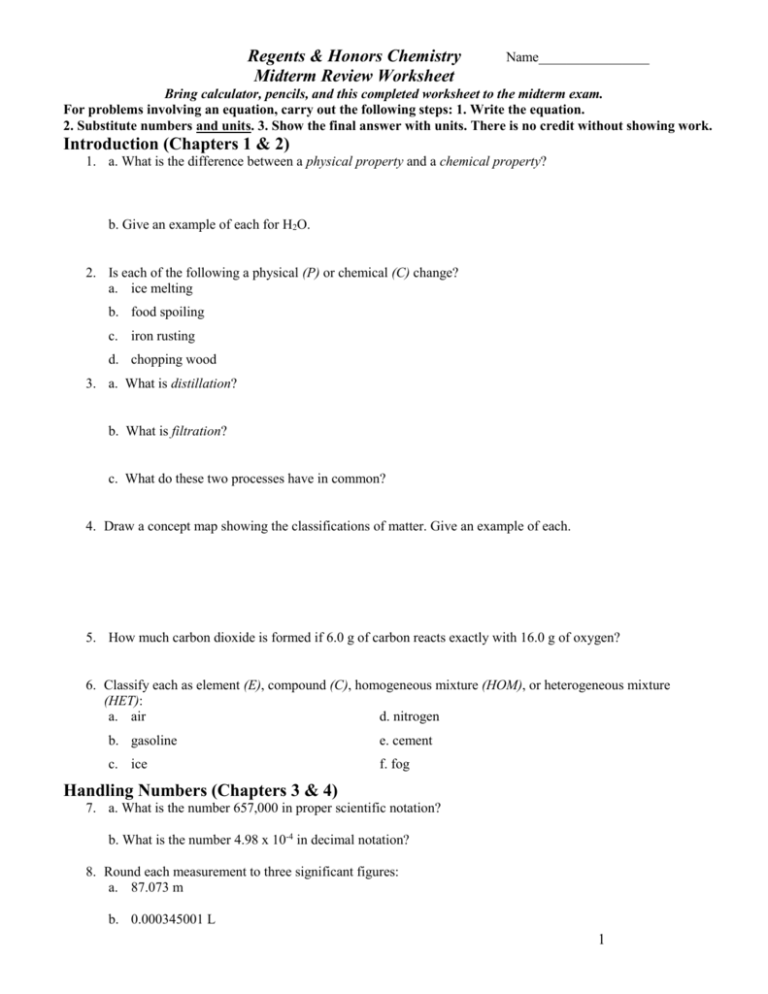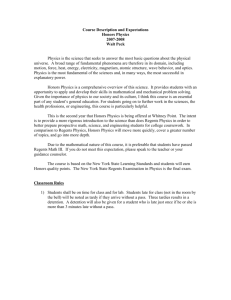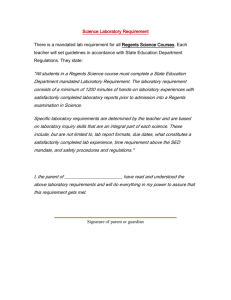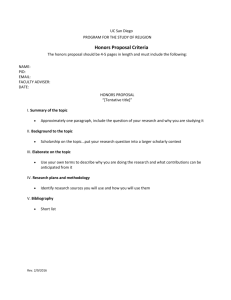Regents & Honors Chemistry Midterm Review Worksheet
advertisement

Regents & Honors Chemistry Midterm Review Worksheet Name________________ Bring calculator, pencils, and this completed worksheet to the midterm exam. For problems involving an equation, carry out the following steps: 1. Write the equation. 2. Substitute numbers and units. 3. Show the final answer with units. There is no credit without showing work. Introduction (Chapters 1 & 2) 1. a. What is the difference between a physical property and a chemical property? b. Give an example of each for H2O. 2. Is each of the following a physical (P) or chemical (C) change? a. ice melting b. food spoiling c. iron rusting d. chopping wood 3. a. What is distillation? b. What is filtration? c. What do these two processes have in common? 4. Draw a concept map showing the classifications of matter. Give an example of each. 5. How much carbon dioxide is formed if 6.0 g of carbon reacts exactly with 16.0 g of oxygen? 6. Classify each as element (E), compound (C), homogeneous mixture (HOM), or heterogeneous mixture (HET): a. air d. nitrogen b. gasoline e. cement c. ice f. fog Handling Numbers (Chapters 3 & 4) 7. a. What is the number 657,000 in proper scientific notation? b. What is the number 4.98 x 10-4 in decimal notation? 8. Round each measurement to three significant figures: a. 87.073 m b. 0.000345001 L 1 Regents & Honors Chemistry Midterm Review Worksheet 9. Solve the following and express the result in proper scientific notation and with the correct number of significant figures: a. 7.18 + 5.384 = b. (6.3 x 10-3) x (2.156 x 104) = 10. Calculate the percent error if a student measures the density of gold to be 17.2 g/cm3. Use Table S to find the accepted value for the density of gold is 19.3 g/cm3. 11. Do the following conversions: a. How many liters are 34 mL? b. How many grams are 65 mg? c. How many mm are 3.0 km? d. How many K is 340oC? 12. Would a plastic ball with a mass of 35 g and a volume of 42 cm3 sink or float in water? 13. Convert 65 mph (miles per hour) to m/s. (1609m = 1mi). Compounds (Chapter 6) 14. a. What is the difference between an ion and an atom of the same element? b. What is a cation and what is an anion? c. How many protons and electrons does the aluminum ion have? 15. a. What is the basic unit of a molecular compound called? b. What is the basic unit of an ionic compound called? 16. What are several general differences in physical properties between molecular and ionic compounds? 2 Regents & Honors Chemistry Midterm Review Worksheet 17. Write the symbol for the ions of the following elements showing the correct charges: a. aluminum d. oxygen b. sodium e. iron c. neon f. lead 18. Name the following ions and/or compounds: a. NH4+ d. Fe+2 b. N2O5 e. CuO c. K2CrO4 f. H2CO3 19. Write the formula for the following compounds. State whether each is ionic (I) or molecular (M). a. magnesium hydrogen carbonate b. sulfur trioxide c. nitric acid d. calcium sulfide e. ammonium phosphate f. iron(III) carbonate Atoms, Electrons, and Periodic Relationships (Chapters 5, 13, & 14) 20. What did Rutherford conclude from his gold foil experiment? 21. a. Fill in the table concerning the three subatomic particles that make up an atom. Symbol Charge Mass (amu) Location in the atom 22. How many protons, neutrons and electrons are in the following atoms: Protons Neutrons Electrons Ne-20 Fe-55 2 H 1 23. a. Define: a. mass number b. atomic number c. atomic mass 24. What is the mass number and atomic number of Fe-55? 25. What is the isotope notation of the element that has a mass number of 47 and 25 neutrons? 3 Regents & Honors Chemistry Midterm Review Worksheet 26. Rubidium has two naturally occurring isotopes. One isotope has an abundance of 72.2% and its mass is 84.9 amu. The other isotope has an abundance of 27.8% and its mass is 87.0 amu. Determine the atomic mass of rubidium. 27. State the key features (focus especially on the electrons), and draw a diagram showing a model of the atom according to: Dalton Bohr Quantum Mechanics 28. Describe, in detail, how the emission spectrum of neon in a neon light works. 29. Define: a. Orbital b. Ground state c. Excited state 30. Give the Regents chart electron configuration and the number of valence electrons in: Regents e- Config. No. Valence eCarbon atom Magnesium atom Iron atom Chloride ion 31. Define: a. electronegativity b. ionization energy 32. State the trends (increases (I) or decreases (D)) and give a brief explanation for the following properties: a. top to bottom in Group 2: the atomic radius b. left to right in Period 2: the atomic radius c. top to bottom in Group 16: the first ionization energy d. left to right in Period 2: first ionization energy e. top to bottom in Group 17: electronegativity f. top to bottom in Group 14: metallic character 4 Regents & Honors Chemistry Midterm Review Worksheet 33. Which elements (general name) on the Periodic Table are usually found in salts that form colored aqueous solutions? 34. As a metal atom forms a cation, does the size increase, decrease, or remain the same? Why? 35. As a nonmetal atom forms an anion, does the size increase, decrease, or remain the same? Why? Ionic, Covalent, and Metallic Bonding (Chapters 15 & 16) 36. Define “ionic bond”. 37. Why do metals tend to form cations and nonmetals tend to form anions? 38. Which pair of elements are likely to form ionic compounds (I) or molecular(M) compounds? a. chlorine and bromine b. lithium and chlorine c. potassium and helium d. iodine and sodium 39. Explain why ionic compounds are electrically neutral. 40. Explain why molten MgCl2 and MgCl2(aq) conduct an electric current although crystalline MgCl2 does not. 41. Define “metallic bond”. 42. Explain why metals are good conductors of electricity. 43. What is an “alloy”? 44. Explain why neon is monatomic but chlorine is diatomic. 45. Draw the electron dot structure for: a. I2 b. NH3 c. CH4 d. H2O 46. How many electrons are shared between two atoms in a double covalent bond? How many in a triple covalent bond? 5 Regents & Honors Chemistry Midterm Review Worksheet 47. Draw the electron dot formula for: a. HCN b. CO2 48. Use VESPR theory to predict the shapes of the following species: a. CO2 b. SO3 c. CH4 d. NH3 49. Not every molecule with polar bonds is polar. Explain this statement. Use CCl4 as an example. 50. The bonds between the following pairs of elements are covalent. Arrange them in order of increasing polarity. a. H-Cl b. H-F c. H-H d. H-C e. H-O f. S-Cl 51. Draw the electron dot structure for each molecule. Identify polar covalent bonds by assigning slightly positive (+) and slightly negative (-) symbols to the appropriate atoms. a. BrCl b. HBr c. H2O 52. Which of these molecules would you expect to be polar? (Hint: use VSEPR to determine the molecular shape whether the molecule is symmetrical.) a. SO2 b. H2S c. CO2 d. BF3 Chemical Reactions (Chapter 8) 53. What are the five classes of chemical reactions? For each type of reaction, what do you look for to tell which class of reaction it is? 1. 2. 3. 4. 5. 54. a. Which Regents table is used to predict whether a single replacement reaction takes place? b. What is meant by “calcium is more active than lead”? 6 Regents & Honors Chemistry Midterm Review Worksheet 55. a. What are the three conditions that “drive” double replacement reactions? b. When do you use Regents Table F? 56. For each of the following reactions, (1) name the class of the reaction, and (2) predict the products and write a balance chemical equation including states: a. Aqueous solutions of calcium bromide and sodium carbonate are mixed. b. Aluminum reacts with chlorine to form aluminum chloride. c. Complete combustion of butane (C4H10). d. Fluorine gas is bubbled through an aqueous solution of sodium chloride. e. Magnesium carbonate is heated, yielding magnesium oxide and carbon dioxide. f. Zinc metal and an aqueous solution of sodium phosphate are mixed. 57. Write net ionic equations for 56a and list the spectator ions. The Mole & Stoichiometry (Chapters 7 & 9) 58. Do the following conversions: a. How many molecules in 2.35 mol SO3? b. How many atoms in 2.35 mol SO3? c. How many moles are 6.75 x 1022 formula units of calcium carbonate? d. How many grams are 6.4 mol H2O? e. How many liters are 3.6 mol CO2 at STP? f. How many atoms are in 35 L He at STP? 7 Regents & Honors Chemistry Midterm Review Worksheet 59. Write the formula for sodium carbonate. What is the percent composition of each element in sodium carbonate? 60. What is the molecular formula for a compound with an empirical formula of C3H5O2 and a molar mass of 146 g/mol? 61. If a molecular compound is 25.9% N and 74.1% O, what is its empirical formula? 62. (Honors only) What is the molar mass of a gas with a density of 2.57 g/L? 63. For the reaction: 3NO2(g) + H2O(l) 2HNO3(aq) + NO(g): a. How many mol NO can be formed from 0.23 mol NO2? b. How many liters (at STP) of NO can be formed from 6.2 mol H2O? c. How many molecules of NO can be formed from 16 g NO2? d. How many grams of HNO3 can be formed from 75 g NO2? 64. (Honors only) For the reaction in problem 63, what is the limiting reagent if 37 g NO2 reacts with 8.0 g H2O? How much of the excess reagent remains after the reaction? 65. (Honors only) What is the percent yield in problem 64 if 6.2 g NO is actually produced? 8




